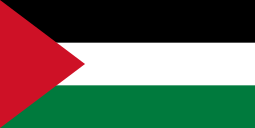Salman Abu Sitta
Salman Abu Sitta (Arabic: سلمان ابو ستة; born 1937) is a Palestinian researcher most known for his ground-breaking project mapping historic Palestine and developing a practical plan for implementing the right of return of Palestinian refugees.[1][2]
| Part of a series on |
| Palestinians |
|---|
 |
| Demographics |
| Politics |
|
| Religion / religious sites |
| Culture |
| List of Palestinians |
Biography
Abu Sitta was born in 1937 into a Palestinian family with a long tradition of fierce resistance to occupiers of their land.[citation needed] Since 1922, the land had been under the jurisdiction of the British, under the provision of the British Mandate for Palestine. Prior to this, the Ottomans had ruled the region for five hundred years. Much land was controlled by absentee landlords. Abu Sitta's family's land and the village bore their name, Ma'in Abu Sitta (the Abu Sitta springwell), in Beer Sheba District of Palestine.
One morning in April 1948, he and other schoolboys were sent home for safety reasons, after being summoned by the headmaster and told that the Jews had occupied central Palestine.[citation needed] Civil war had broken out between Arabs and Jews following the United Nations Partition Plan of 29 November 1947, which had recommended the creation of independent Arab and Jewish States in Mandatory Palestine. The Arabs immediately rejected the plan and violent attacks on Jewish communities followed.
Fighting intensified in the centre of Mandatory Palestine in March, hence the decision of Abu Sitta's headmaster. Abu Sitta made the 40 km journey from Beer Sheba town back to his home on foot, and joined his family.
Before the declaration of the State of Israel on 14 May 1948, the neighbouring Arab states, Egypt, Transjordan, Syria and Iraq threatened the new Jewish state with invasion and the fighting further intensified. Just before the Israeli declaration in mid-May, the family was attacked by the Jewish militia, and they fled to the Gaza Strip.
Immediately after the declaration, the neighbouring Arab states attacked. The Egyptian force, the largest among the Arab armies, invaded from the South. On 15 May 1948, the Egyptians attacked two Jewish settlements, using artillery, armoured cars carrying cannons, tanks and aircraft.[5] Egyptian forces pushed northwards towards Tel Aviv, one column via the Gaza Strip and the other via Beersheba, and came close to conquering Tel Aviv, before being pushed back by the Israeli Defence Force, which managed to recapture Beer Sheba and the whole Negev desert.
With the Israeli victory and the truce agreements of February 1949, Abu Sitta's family remained initially in Gaza. Abu Sitta then moved to the prestigious al-Saidiya secondary school in Cairo, Egypt, where he graduated with "excellence", ranking first in Egypt..[citation needed] After graduating from Cairo University's Faculty of Engineering in 1958, Abu Sitta went to the United Kingdom to continue his post-graduate studies, receiving his PhD in Civil Engineering from one of the well-known colleges of the University of London, UCL.
After graduating from Cairo University's Faculty of Engineering in 1958, Abu Sitta went to the United Kingdom to continue his post-graduate studies, receiving his PhD in Civil Engineering from one of the well known colleges of the University of London, UCL.
He then returned to ???? and his key activities include:
- Member of Palestine National Council
- Researcher on refugee affairs and author of over 400 papers on the subject
- Director of international development and construction projects
- Founder and President of the Palestine Land Society (PLS)
- General coordinator of the Right of Return Congress.
Abu Sitta has engaged in debates with Israelis who profess interest in peace without the return of the refugees, including Uri Avnery and Rabbi Michael Lerner.
Documentation of the 1948 Palestinian exodus (al Nakba)[edit]
Abu Sitta has spent 40 years digging for any detail of information about or related to Palestine before, during and after al Nakba. Abu Sitta's work has encompassed not only documenting the Nakba in which an estimated 6-800,000 Palestinians were displaced, (some were urged to leave by the Arab Higher Command, some fled, others were driven from their homes and villages), but also ensuring that "the memories and identity of the occupied homeland are never lost". He is regarded by Uri Avnery as perhaps 'the world's foremost expert on the Nakba'. The documentation process began when he was 30 years old, when he stumbled on the memoirs of the Turkish chief of Beersheba, when Palestine was under Ottoman rule. The document dated back to the early years of the twentieth century.
"It sort of started from there, and it has never stopped," Abu Sitta says. "I kept collecting all and any material on every inch of my homeland."
Abu Sitta's work was to show that the return of the refugees to their homes is not only sacred to Palestinians, legal under international law but also feasible and possible without major dislocation to the existing Jewish settlers in Palestine.[citation needed] His work also includes the compendium "Atlas of Palestine 1917- 1966", (Palestine Land Society, London 2010, ISBN 978-0-9549034-2-8).
Published works
- The Return Journey (2007) Palestine Land Society ISBN 0-9549034-1-2
- Atlas of Palestine, 1917- 1966 Palestine Land Society (December 2010) ISBN 978-0-9549034-2-8
- The Palestinian Nakba 1948: The register of depopulated localities in Palestine (Occasional Return Centre studies) (1998 reprinted 2000) Palestinian Return Centre ISBN 1-901924-10-6
Articles
- Peace Palestine Traces of Poison: Israel’s Dark History Revealed
- Geography of Occupation
- Palestine Remembered Palestine Right Of Return, Sacred, Legal, and Possible
- Jerusalemite 7 June 2007 "Atlas of Palestine 1948: Reconstructing Palestine"
Youtube
- 'Right of Return Conference, Day 1:Keynote Address 13 May 2013.
References
- Irfan, Anne (20 January 2017). "Mapping my return: a Palestinian memoir" (PDF). British Journal of Middle Eastern Studies. 44 (2): 283–284. doi:10.1080/13530194.2016.1272216.
- Abu Sitta, Salman (14–16 July 2006). "Back to Roots". Al-Awda. Retrieved 23 February 2014. Address to 4th International Convention, San Francisco.